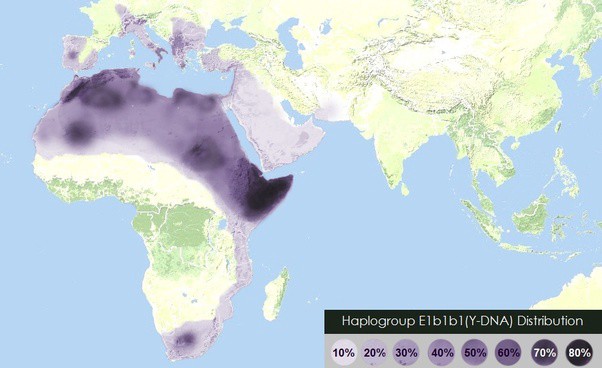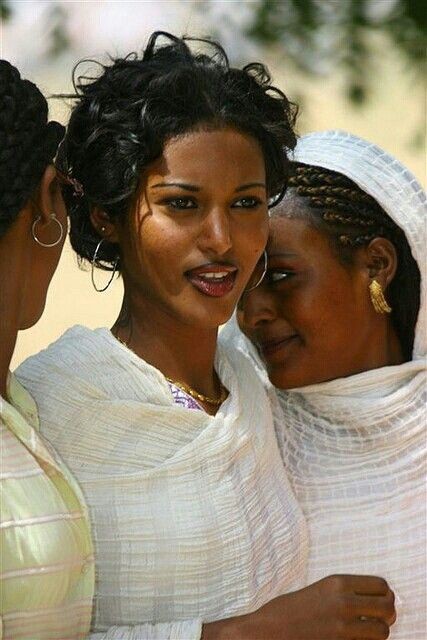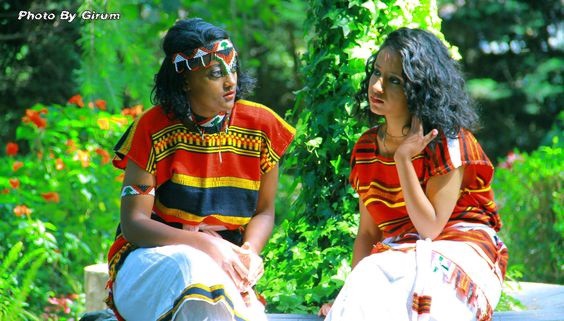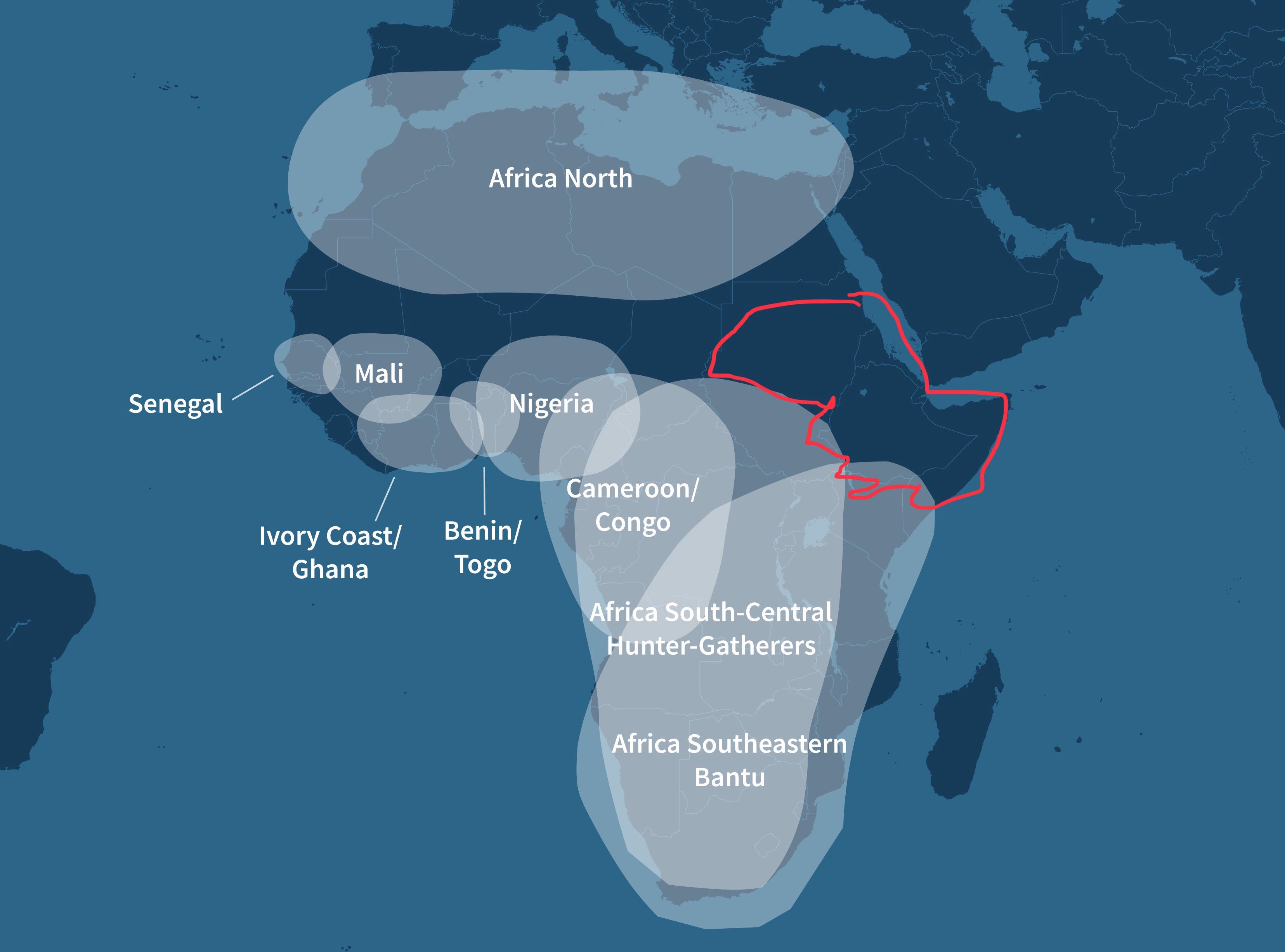Originally Written by Gamadiid Buraale (https://www.quora.com/Are-Somalis-a-combination-between-Bantus-and-Arabs-Caucasians-non-African) , Sagal Amal & Didi Bane (https://www.quora.com/Why-do-Somali-people-look-different-from-other-Black-people-1) on Quora.com, and NiloSaharan (username) on Anthrogenica.com (https://anthrogenica.com/archive/index.php/t-7619.html); Additional Information Added, Compiled, Edited, and Republished by The Habesha Union (Instagram: @habesha_union; Medium.com: @habeshaunion) on Medium.com.
*A portion of the original texts by Gamadiid Buraale and Sagal Amal, were intended to defend the Somali stance, while this highly also applies to other Habeshas, Horn Africans-Northeast Africans (Nilo-Cushites/Nilo-Cushtic peoples) in general.*
- Question: ?Are Somalis a combination between Bantus and Arabs/Caucasians/non-Africans?? (Answered by: Gamadiid Buraale)
Thanks for the A2A. The short answer is no but this question is common enough that it warrants a thorough response in order to diminish the confusion surrounding the topic.
Many things all lead to this idea to being untrue and this will be covered.
History
While East Africa is very diverse today, mainly home to Bantus in most parts of it, Nilotic peoples, and Afroasiatic peoples in the Horn, it looked different a few thousand or even hundreds of years ago.
Most of East Africa was inhabited by Afroasiatic (specifically Cushitic speaking groups) and Khoisan peoples. Even northern Sudan was predominantly populated by what some believe to be Afroasiatic or Cushitic peoples before an influx of Nilotes led to a language shift.
Proto-Bantu originated in West Africa, specifically Nigeria and Cameroon roughly 4000?3500 years ago when it split off from other Bantoid languages. While other groups today dominate these countries, Bantu languages and peoples still exist in small numbers in this place of origin (except in Cameroon where Bantu/Bantoid peoples make up the majority). Not only East Africa was changed, but the entirety of Africa, by the Bantu expansion that took place 3000 years ago. It was a series of waves of migration that lasted 2500 years. They moved to Central Africa, reaching East Africa 2000?1500 years ago. This led to the displacement of hunter-gatherer Khoisans and pastoral Cushites in East Africa. Khoisans moved south and mostly persist now in arid and desert regions of Southern Africa today.
So Bantu peoples did not reach anywhere near Somalia until roughly 2000?1500 years ago.
In contrast, Somali is a Cushitic language, a branch of Afroasiatic languages. Afroasiatic languages and Cushitic languages in particular are theorized to have originated in northeast Africa. Cave paintings, fossil evidence, written records, pyramidical structures, mausoleums, ruined cities, stone walls, graves, etc all clearly depict an ancient, sophisticated civilization that existed in Somalia as early as 4000 years ago. The lifestyle, culture, and appearance of the people depicted all are uniquely Somali and Cushitic. In other words, according to history, a Somali people existed 4000 years ago.
The earliest mention of Arabs was in 9th century BC, less than 3000 years ago, long after records mentioning ancient Somalis, who were prominent in the ancient world. Had Arabs been influential and engaged in intercontinental exchanges, there would have been earlier mention of them and historical records of anything resembling a relationship, let alone influence on, ancient Somalis.
To sum it up: History shows that a Somali people existed 4000 years ago, highly similar in appearance, culture, and lifestyle as they do today. This predates the first mention of an Arab people (3000 years ago) in historical records and the period when Bantu peoples first migrated in any region near Somalia (2000?1500 years ago).
So it is impossible, for this and a plethora of other reasons, to postulate tha Somalis are a mix of Bantus and Arabs.
Genetics
Genetic studies show Somalis to be most closely related to other Cushitic peoples of East and North Africa: such as the Afar, Oromo, Beja/Bischarin, Bilen, Saho peoples. They also show genetic affiliation to Berbers, more so than to Arabs or other sub-Saharan Africans. All humans are related to an extent, after all we are one race. But genetic studies on ethnic groups show very little, if any, shared maternal or paternal DNA with Bantus.

Distribution map of Y-chromosome haplogroup E1b1b1 which is most heavily concentrated in Somalis, Berbers, and other Cushites.
The few haplogroups Somalis have in common with Middle Eastern peoples is due to their common Proto-Afroasiatic ancestry, a lineage that originated in Africa.
There is also the matter of appearance. Generally speaking, Somalis are a tall people with a slight build, with small and narrow noses, oval face shapes, and almond-shaped eyes. Their hair is usually fine and curly although it is not uncommon for Somalis to have naturally wavy, straight, and sometimes kinky hair. Both Bantu and Arab people are typically shorter in stature than Somalis, with a larger bone structure of the body, both typically have coarse hair. A combination of the two groups would not lead to a people resembling Somalis. Instead, Somalis resemble other Cushitic, northeast African, and Berber peoples.

A Somali man

A Somali woman (a Cushitic ethnic group that inhabit Somalia, Djibouti, Ogaden, NFD)

An Afar woman in Eritrea (Cushitic group in Djibouti, Eritrea, Ethiopia)

Oromo women (a Cushitic group that inhabits Ethiopia and Kenya)
?.
Saho women (a Cushitic group of Eritrea and Ethiopia)
?
Beja man (Cushitic group native to southern Egypt, northern Sudan, and Eritrea)
?
Tuareg female (a Berber people that live in the Sahelian region of Libya, Niger, Mali, Burkina Faso, Algeria, Tunisia)
It is clear that the distinct look of Somalis is shared with other Cushitic peoples and Berbers. It is inaccurate to claim that these peoples are all a mix of Bantu and Arabs when both historical, genetic, and linguistic evidence shows that they are a distinct, ancient indigenous group. The diversity of features and genes of native Africans attests to the antiquity of Africans as a whole and to assume that they should conform to any one look makes little sense in light of this.
Edit: I have just read the comment to the question. The popular DNA tests that have become a fad now are notoriously inaccurate, particularly when it comes to underrepresented non-Europeans. They mostly compare clients? submitted DNA to other clients? instead of relying on scientific studies and knowledge on the DNA of ethnic groups. As time went on, 23andme specifically saw this lack of information they had on northeast Africans and provided DNA free to these people in order to improve their results. This has led to 23andme being slightly i ? and I use the term loosely ? than other companies. However, they still erroneously attribute certain markers as being ?North African/Middle Eastern? among Somalis and other northeast Africans when years of academic research into Somali genetics has led to very different findings.
- Question: ?Why do Somali people look different from other Black people?? (Answered by: Sagal Amal & Didi Bane)
Sagal Amal:
Do you really expect everyone who has genetic ties to Africa to have the same features? Come on. Soon you?ll be asking about why the Khoisan people look East Asian. Guess what ? they aren?t related. I?m getting tired of these questions. Somalis are (mostly) over sixty percent native East african. They are closely related to the Afar, Oromo and Beja people who are also dark skinned and curly haired. Not all Africans have tightly coiled hair you know. Although many do claim recent Arab ancestry which I don?t doubt considering the closeness between Somalia and the Arabian peninsula and also the fact that most if not all people are Muslim. There are even many Arabs living in Somalia now. That?s not to say there are also people who come from tribes with Bantu ancestry, who exhibit your stereotype of black people. All of my siblings except for me have a broad nose, but all of us have curly hair, excluding my dad, who has nearly straight hair and dark skin, and he?s the one who gave my siblings his nose.
So why do Somalis look different from other black people? The answer is they don?t. Your stereotype is wrong. The oldest human fossils were found in Africa and all people have African features, not the other way around. You see, Africa is the most genetically diverse continent in the world. Why should all Africans look the same?
Edit: I am so cringing right now. Somalis are actually on average less than a quarter Arabian, give or take a few. And by the way my siblings don?t have broad noses, they just have huge nostrils, don?t know where that came from. My dad?s nose is pointed at the tip.
Didi Bane:
That?s a myth. As not all Somalians look alike nor do other Black Africans on the continent. Africa is the most diverse continent on the planet both genetically and phenotypically according to modern anthropologists and geneticists. Blackness has usually been defined by Europeans with a Eurocentric viewpoint which tended to further divide Africans along their physical traits which led to Ethnic tensions and civil wars years later after the end of colonialism. There is no such thing as one type of ?Black look?. Plus most Blacks in the West tend to originate from certain West African ethnic groups like the Igbo, Yoruba, Ewe, Fon, Wolof, Mandinka, Mende, Akan, Ashanti etc people and Africa has more than 3000 different Ethnic groups and you cannot expect them to look the same. Finns don?t look like Sicilians yet they are both considered White European. ?
-x-Here is just some of the diversity of Black Africans.-x- [It would not let me copy and past the photos, here are some links to pictures of Horn Africans-Northeast Africans:
Somalian Woman: https://qph.fs.quoracdn.net/main-qimg-8c717a60cfd90299b81cd209c9ffc583.webp
People of various Horn African-North East African ethnicities; this Instagram page tries to represent all Horn Africans but runs into constraints for a lack of resources; a majority of the people in the posts are people of the Habesha pan-ethnicity (Oromos, Afars, Amharas, Gurages, Tigray-Tigrinya, Somalis, Nuer, etc. to name a few) or in other words Ethiopians, Eritreans of the various ethnicities within these countries, as well as some Somalis of Somalia): https://www.instagram.com/habesha_union/?
Somalian Man: https://qph.fs.quoracdn.net/main-qimg-1d10e7f407d9e2ad3b5dea96533958e1.webp
Nuer Man from Ethiopa: https://qph.fs.quoracdn.net/main-qimg-9b632386c21ef81e2364ab42781f062b.webp
Afar girl from Ethiopia: https://qph.fs.quoracdn.net/main-qimg-db8f205b782c353c53a10c0e06ac2989.webp
Oromo man from Ethiopia: https://qph.fs.quoracdn.net/main-qimg-41621403734f74bf33e501753a2363e1.webp .
- Question: ?My fellow Africans share your ancestral results from different DNA companies? (Thread was started by SWAHILLI_PRINCE16 but this text was written in reprocess by NiloSaharan).
NiloSaharan (username):
If you?re of predominant SSA ancestry, I wouldn?t give much of these DNA companies any merit when it comes to ancestral admixture (especially if you?re of NS or East-African ancestry) ? we?re a minority within a minority. Unfortunately we?re not big enough a market for DNA vendors to focus on meaningful clusters for our region. The same holds true for other groups like Native Americans and many other Asian customers.
Some of the funniest examples of blatant over-simplification are Ancestry.com?s branding of Southeastern Bantu for 1/3 of the continent :doh:I?m stated as 98% Southeastern Bantu without any regard of my Pygmy, Nilotic and EHG (*however small albeit) affinity which are found in other more comprehensive admix calcs.
23andMe has a cluster for Sardinians yet has the audacity to brush 100?s of millions of East-Africans in one cluster :crazy:
For more meaningful labels of African clusters, I?d refer to genealogists who specialize on African populations ? Tishkoff?s (http://www.ncbi.nlm.nih.gov/pmc/articles/PMC2947357/) papers are great examples!
Here?s an extract from the paper stating a K=14 Structure ? I?d rely more on these clusters than most DNA companies ? vendors that don?t have similar breakdowns for SSA customers should be dismissed if you?re trying to find any meaningful breakdowns of your SSA ancestry:
http://i.imgur.com/kIUYSV0.png?1
Here?s another extract with a geographic overlay along with some populations (http://www.ncbi.nlm.nih.gov/core/lw/2.0/html/tileshop_pmc/tileshop_pmc_inline.html?title=Click%20on%20image% 20to%20zoom&p=PMC3&id=2947357_nihms-231118-f0005.jpg)
? I didn?t know the Masai blood amongst Central and Western Kenya is a major admix component. 60?75% East African? could it be a constant ancient admixture between the Masai and Bantu which has been maintained over time? I myself score almost 1/4 East African with no known Masai ancestor in my bloodline. One of my Kikuyu grandmothers does get confused for being Somalian I gueas thats where the majority of my East African genes come from.
Another thing I?ve observed is the low Central African genes amongst them I guess thats accurate IMObecause the South/Central HG were not really Nomads
Why are they scoring tiny bits of European, EA/NA and ME/NA could it be from the interaction from the outside world or just the Cushitic admix?
Here are the two Kikuyus..
10215
10214
By ?Central? are your referring to (Nilo-Saharan)? or CushiticNS with ?Massai blood?? ? the clusters mentioned in the paper should help clarify the clusters you?re referring to. *The last image has a breakdown of different Kenyan?s AAC. The labels of ethnicitiestribes don?t hold much bearing when we?re referring to ancient ancestral clusters ? so there?s no such thing as ?MasaiEast-African genescomponents?. It?d be better to refrain from using these terms in place of labels such as Cushitic, Nilo-Saharan, Chadic etc. *There are a few exceptions of singular tribes with their own clusters; the tishkoff paper has the Fulani form their own.
Try not to get too boggled-up with 23andMe?s SSA clusters, they?ve done a very poor job in regards to clusteringreferencing native SSA populations ? ex. I score in the mid-high 9% for Pygmy on puntDNAL and DNA.land but score 3.4% on 23andMe?s Central African cluster despite them stating this grouping has Biaka and Mbuti Pygmy samples among other HGs which I still didn?t score for on their admix calc.
For someone from Central-Eastern Africa, puntDNAL?s Africa only calc has been the most meaningful as of yet.
? ? ? ? ? ? ? ? ? ? ? ? ? ? ? ? ? ? ? ? ? ? ? ? ?
Additional Information by The Habesha Union:
In a future article I will explain how/why most-if-not-all Ancestry/Ethnicity Estimate DNA Tests misrepresent Nilo-Cushites (Nilo-Cushitic peoples, Horn Africans-Northeast Africans) as ?a combination between Bantus and Arabs [or] Caucasians.? One thing for sure is that most of them don?t test/look for Nilo-Cushitic markers, (1) because they have limited data, (2) it was originally meant for European Americans (U.S. White Americans) descended from colonists, indentured servants, and those various European ethnicities that asimilated with limited traces into the White population, so they can find out/corroborate weather their ancestors came from a certain part of Europe that they have lost a connection with/forgot about (as Ancestry/Ethnicity Estimate DNA Testing Companies advertise, for some European Americans it can not only tell them about their ancestors? ethnicity but can supposedly also pinpoint from which village or town in a specific European countries? province their ancestors come from; this has not been adequately verified though) and secondly meant for African Americans (U.S. Black Americans) descended from West-Central African peoples sold into slavery via the Transatlantic Slave Trade (with some populations going through Central-South America & Latin America before reaching the United States), (3) in some cases it can?t tell the difference between an East African and a West Asian, (4) it doesn’t even consider Nilo-Cushites as a unique group of peoples but brands them as ???Southeast Bantu + Middle Eastern?? = a bunch of random people who say they come from an imaginary place called the Horn of Africa.? On Ancestry DNA?s map of Genetic Group Estimates, they didn?t even highlight the Horn of Africa (more specifically any place from Central Sudan to as far south as Somalia), the map makes it look like the place is uninhabited and dosen?t even give it a Genetic Group Estimate name. In the picture bellow, the part of the map circled in red should be the Nilo-Cushitic Genetic Region (I had to circle this myself, because they never took this area into consideration, when it comes to DNA Genetic Ancestry Group Estimates) ? (I?ll give you my citation later).
 Ancestry DNA Map of Africa. The part of the map I circled in red should have been Nilo-Cushitic instead of a blank space left there by the Ancestry DNA Testing Company.
Ancestry DNA Map of Africa. The part of the map I circled in red should have been Nilo-Cushitic instead of a blank space left there by the Ancestry DNA Testing Company.
Ancestry DNA Map of Africa. The part of the map I circled in red should have been Nilo-Cushitic instead of a blank space left there by the Ancestry DNA Testing Company.
? ? ? ? ? ? ? ? ? ? ? ? ? ? ? ? ? ? ? ? ? ? ? ? ? ? ? ? ? ? ?
In responce to comments:
This may be true, I?ll give you the benefit of the doubt when you say ancient admixture, but generally speaking these commercial DNA Tests are supposed to show only recent ethno-genetic marchers. For example Southern Europeans (in this example, this double standard is visible in Italians) have a huge amount of admixture that is way more recent than Horn Africans? ?Ancient Admixture?. But with this Italians having a lot more recent Arab, other Middle Eastern, and Magrabi/North African proper (Berbers, both Arabized NAs and non-Arabized Black North African populations) admixtures but are still categorized as Italians and Southern Europeans. While, when it comes to Horn Africans (genetically speaking Sudanese are included), there are no categories (possibly for a lack of Data, they partially admit to this), Horn Africans are categorized as biracial Southwestern Bantu & Arab. There are no catagories parameters like ?Horn African,? ?Cushitic?, ?Nilo-Saharan,? ?Nilo-Cushitic,? ?Somali,? ?South-Central Ethiopian,? ?Highland Ethio-Eritrean,? etc. In retrospect, Italians with fairly more recent admixture, are considered Italians within their own right, even to the extent that these Commercial DNA tests can name exact ethnic groups like Sicilian, and while ethnic Sicilians have the most non-European admixture among all other Italian ethnic groups. For their lack of data and commercial monetary profit interests, these commercial DNA tests can?t tell the difference between Nilo-Cushitite (Horn Africans/Northeast Africa south of Egypt ? the area between Sudan to the north and Somalia to the south), and Southwestern Bantu of Kenya, Uganda, etc. and Arabs of Yemen, Saudi Arabia, etc., while it can easily tell the difference between a Northern Italian and an ethnic Sicilian (and other Southern Italians), plus when it comes to the British Isles, they can even pinpoint exact villages let alone a geographic region, ethnolinguistic groups, country, or ethnic group, which it can?t even do for Horn Africans. Also with this Ancient Admixture talk, ethnonationalist African Americans and West Africans have used this minuscule notion as a way to deny that Horn Africans are truly African or Black enough.
? ?
Habesha Union | ???:[?????] [FOR THE ModernRealLife Pan-Ethnic #Habesha CULTURE+HISTORY+COMEDY] From Around The World [via: @habesha_union][Inspired by:BunaTime @habeshacomedies]


